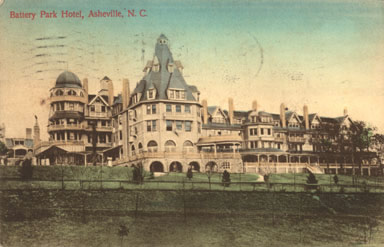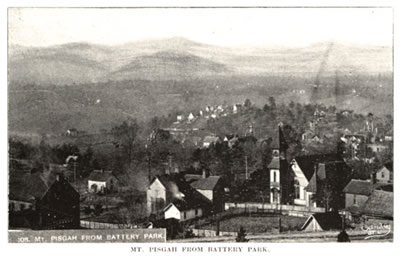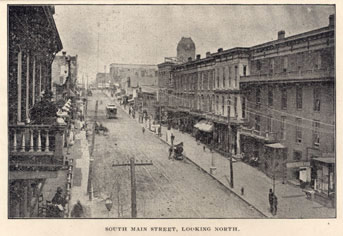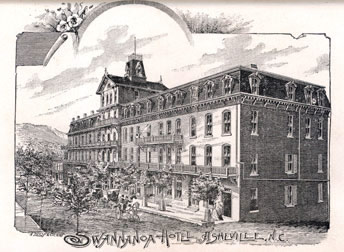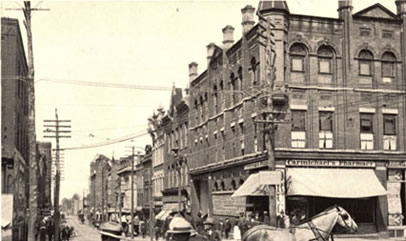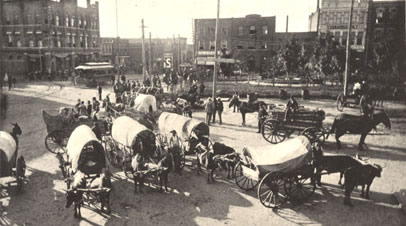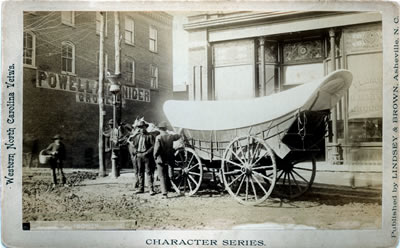Travel Western North Carolina
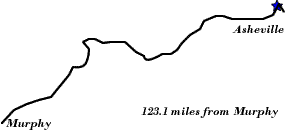
Following Wagon Trails - 1890s: Asheville
Buncombe County
County Seat
These two pictures, one of the Battery Park Hotel and the other of the view of Mt. Pisgah from the hotel, illustrate the attraction of Asheville, N.C., to tourists. The town provided first-class accommodations combined with scenic vistas and the amenities of an urban, social setting. This postcard view of the Battery Park Hotel shows its scale and a hint of its prominent setting. Having emerged as a premier tourist destination by the 1880s, Asheville drew the attention of millionaire George Vanderbilt. Some sources speculate that Vanderbilt, during a stay at the Battery Park Hotel in 1886, first envisioned establishing the rural retreat which evolved into his palatial Biltmore Estate. The picture of “Mt. Pisgah from Battery Park,” from Harriet Adams Sawyer’s Souvenir of Asheville or the Skyland (1892) illustrates not only the prominence of Mt. Pisgah along the skyline but also the overall mountain setting.
Battery Park Hotel, Asheville, N.C.
“The building is now in course of construction, and is to be completed this summer for occupancy. It is both a winter and summer hotel, all rooms having open fireplaces, and the building being heated throughout by steam. In size it is 200 feet long in frontage, and 170 feet deep; average width, 52 feet 6 inches. The tower, which is at the angle overlooking the French Broad River, is 150 feet high, and has an extended view, both up and down the valley, of over 200 miles. The location is on a knob of the Blue Ridge, on what was, during the late war, the site of Battery Porter, the old earthworks having to be removed to make way for the present building. The altitude is 2,800 feet above the sea, on the line of the Western North Carolina Railroad. There are one hundred and fifty chambers, and accommodation for four hundred to five hundred guests. The dining-room is 40 feet by 90 feet, clear of all posts or columns. The building is provided with steam, elevator, and lighted throughout, with Edison electric light. The owner is Col. Frank Coxe, of Philadelphia. Cost, $100,000 complete.”
- The American Architect and Building News, May 29, 1886
From ProQuest American Periodical Series Online.
In the North Carolina Mountains
“. . . from the Battery Park Hotel, which stands on a hill rising out of the center of the town, the view is of singular grandeur. From the south far into the north a line of peaks swings in an arc nearly fifty miles in length, and when the sun sets behind this wall of mountains, the effect of color, almost etherealizing so many peaks in gold and purple, will have memories which can never be forgotten.”
- Christian Union, June 21, 1888
From ProQuest American Periodical Series Online.
Thomas H. Lindsey (1849 - 1927) operated a photographic studio in Asheville, N.C., from 1887 into the1910s. His photographs were publicly distributed as a large series of postcard views, which were listed in Lindsey's own 1890 Lindsey's Guide Book to Western North Carolina as "Lindsey and Brown's Descriptive Catalogue of Photographic Views of The Land of the Sky, or Beauties of Western North Carolina." Lindsey was in business with Edward E. Brown from 1890 - 1891. Among the pictures in Lindsey's Guide was "South Main Street, Looking North, as well as an illustration of the "Swannanoa Hotel, Asheville, N.C."
Concerning the Swannanoa Hotel at this time, Wilbur G. Zeigler and Ben S. Grosscup in their 1883 book The Heart of the Alleghanies (p. 343) remarked:
"Even in daytime a dance is going on in the Swannanoa ballroom on a level with the street. The strains of music from it and whirling figures seen from the sidewalk, will be enough to clinch the opinion that you are in a gay and fashionable summer resort. Every week-day night dances are held at both the Swannanoa and Eagle. If you are single, there is little doubt but you will participate in their revelry; if you have lost the sprightliness of youth or the happy chuckle of healthy later life, in vain you may tuck your head under the pillow and vent your empty maledictions upon the musicians and their lively strains."
Swannanoa Improvements Rapidly Progressing at the Well Known Hotel
"Improvements are rapidly progressing at the popular Swannanoa. The electric motor for the elevator has arrived and will be put in immediately. Yesterday work commenced on the South wall of the office and the center of the partition here is being replaced by a large open fire place. A cloak room is being constructed just in the rear of the office and to the right of the elevator.
The old style front windows in the hotel will be replaced by a handsome glass front. The building is undergoing repairs from garrett to cellar and when completed will be one of the handsomest hotels in the state, and under the genial management of Colonel Lincoln, one of the best conducted hotels in the south.”
- Asheville Daily Gazette, November 30, 1897
Thomas H. Lindsey and Edward E. Brown’s photographic views of western North Carolina not only found a market as postcards but also found their way into travel guides of the era. Among these were Harriet Adams Sawyer’s 1892 Souvenir of Asheville or the Skyland and Holman D. Waldron’s With Pen and Camera thro' the "Land of the Sky.” Waldron's book included these views of “Patton Avenue, Asheville, N.C.” (top) and “The Public Square at Asheville” (bottom).
. . . . “The center of this new vitality is Asheville, a city of nearly ten thousand inhabitants, which has now a national reputation as a resort for health and pleasure seekers . . . . Gay village carts, and horses with mane and tail of conventional cut, dispute the passage in the streets with mule and ox teams. Side by side will be stores, one conducted according to the methods of Eastern cities, another where the woman from the mountains will gather `domestic’ and linsey-woolsey, here tinware and tobacco, in exchange for butter and eggs. `The Square’ and Court-House are still the centers of public congregation, where all classes meet and discuss business, politics, and little `nothings;’ . . . . If the days are fair and the roads good, all goes well; but if the clouds settle and pour their floods for weeks, as sometimes happens, the country folk are kept at home by an insurmountable barrier of mud, and scarcity follows in town. There are amusing scenes after such a period as this. Scow-shaped wagons, with white muslin stretched irregularly over low hickory bows for covers, begin to appear after the first sunshine day. . . . A yoke of oxen drags this queer vehicle with swinging motion into the town square. It will stop anywhere, regardless of crosswalks, and instantly will be attacked on all sides by the citizens. The curtain will be thrown up, and heads poked in to see what there is for sale.
-“In the North Carolina Mountains,” Christian Union, June 21, 1888
Not all travelers to western North Carolina remained within the confines of the major resorts or on the main tourist routes. Courtenay De Kalb, writing in 1892, acknowledged the ready accessibility of hotels in the region and the charms Asheville, but after a brief acknowledgement he chose instead to explore away from the city.
In the Carolina Mountains
“It is easy to pass through this region and know practically nothing of it. The railroad has penetrated it in every quarter, cities having sprung up, splendid hotels have arisen, an exotic semi-metropolitan watering–place life has been transplanted into these mountains. The most perfect climate, both in winter and summer, which can be found east of the Mississippi River has attracted here the hordes of fashion. . . . .
“Time cannot efface the pictures graven upon the memory in our first journey off the beaten paths in North Carolina...
“Following the rocky road down into the valley, a stream soon gathered and kept us company with its cheerful babble. We were now nearing the house where we intended to pass the night. A low, rambling structure, partly of hewn logs, partly weather-boarded, unpainted, and gray with the winds and rains of many summers, amply provided with porches, and having a great stone chimney running up on the outside, could be seen through an intervening grove of oaks. The silence was broken by the hum of a spinning-wheel and the regular beat of the treadle, which seemed to guide the song of a woman spinning – a low, plaintive melody, wild and weird as if compounded of the music of mountain brooks and the moaning of winds in the pines. Civilization brings with it the ballad, but more primitive peoples, however much they may exult in their strength, and make merry at festal seasons, when they sing always strike a note of melancholy.
“Upon entering this mountain home we could almost believe that time had swung backward a century. In a corner stood a loom with an unfinished piece of cloth upon it. Some of the finished product was shown us – coarse blue jeans which would wear like a piece of buckskin, and some lighter cotton goods for women’s’ dresses of plain brown, or white with delicate pink and blue bars, worth, we were told, twenty-five cents a yard. Our hostess was inclined to depreciate her own industry and that of her two daughters, although they had a family of seven to clothe, and mentioned with approbation the wife of a neighbor, who had `right smart spar’ time,’ and would leave a `leg’cy to her own daughter of five thousand yards of cloth, all the work of her own hands!’ . . . .
“. . . The doings of the entire neighborhood passed as in a panorama before us. Last week there had been a `quiltin’ bee’ over at Zeb Poteet’s, with a dance in the evening, which ended in a trial of strength between two stalwart mountain lads over the charms of `Mandy’ . . . .”
- Courtenay De Kalb, Christian Union, January 30, 1892
From ProQuest American Periodical Series Online.
The photographic studio of Lindsey & Brown, in Asheville, N.C., published this postcard showing a wagon, which they captioned a “Prairie Schooner.” The picture was listed for sale in Thomas H. Lindsey’s own book from 1890, Lindsey’s Guide Book to Western North Carolina.
Wilbur G. Zeigler and Ben S. Grosscup described the wagons they saw in western North Carolina in their travel account, The Heart of the Alleghanies, which was published in 1883. In this instance, the authors are in the vicinity of Waynesville, N.C.
“On crossing the state road, the Richland creek road enters a large, unfenced forest, where nearly every evening, in spring, summer, or fall, teamsters, who are either farmers or root buyers, encamp for the night. Their Pennsylvania wagons are like great white-covered scows strangely mounted on wheels. At night, with the light of camp fires thrown on them, they are spectral in their whiteness. Often, in the darkness of the forest, while on our way from the village to our temporary home in the country, we have suddenly run upon these encampments after their fires have smoldered, and only been awakened to a knowledge of their presence by the sharp barking of wakeful dogs.”
- Wilbur G. Zeigler and Ben S. Grosscup, The Heart of the Alleghanies (1883), p. 292.
Return to the Southern Railway Map for the 1890s
Sources & Readings
- Bryan, John Morrill. Biltmore Estate: The Most Distinguished Private Place. New York: Rizzoli International Publications, 1994.
- Greenberg, Sue and Jan Kahn. Asheville: A Postcard History. Dover, N.H.: Arcadia, 1997.
- Lindsey, Thomas H. Lindsey’s Guide Book to Western North Carolina. Asheville, N.C.: Randolph - Kerr Printing Co., 1890.
- McDaniel, Douglas Stuart. Asheville. Charleston, S.C.: Arcadia Pub., 2004.
- Massengill, Stephen E., comp. Photographers in North Carolina: The First Century, 1842 – 1941. Raleigh: Office of Archives and History, North Carolina Department of Cultural Resources, 2004.
- Massengill, Stephen E. Western North Carolina: A Visual Journey through Stereo Views and Photographs. Charleston, S.C.: Arcadia, 1999.
- North Carolina, Department of Agriculture. North Carolina and Its Resources. Winston: M.I. and J.C. Stewart, 1896.
- Sawyer, Harriet Adams. Souvenir of Asheville or the Skyland. St. Louis: Nixon-Jones Printing Co., 1892.
- Sondley, F.A. (Forster Alexander). History of Buncombe County, North Carolina. Asheville, N.C.: Advocate Pub. Co., 1930.
- Swaim, Douglas, ed. Cabins & Castles: The History & Architecture of Buncombe County, North Carolina. City of Asheville, County of Buncombe: Division of Archives and History, North Carolina Department of Cultural Resources, 1981.
- Waldron, Holman D. (text). With Pen and Camera thro' the "Land of the Sky" -- Western North Carolina and the Asheville Plateau. Portland, Me.: Chisholm Bros., 1904.
- Ward, Doris Cline, ed., Charles D. Biddix, associate ed. The Heritage of Old Buncombe County. Asheville, N.C.: Old Buncombe County Genealogical Society, 1981.
- Zeigler, Wilbur G. and Ben S. Grosscup. The Heart of the Alleghanies; Or, Western North Carolina; Comprising Its Topography, History, Resources, People, Narratives, Incidents, and Pictures of Travel, adventures in Hunting and Fishing and Legends of Its Wilderness. Raleigh, N.C.: A. Williams & Co.; Cleveland, O.: W.W. Williams, 1883.
